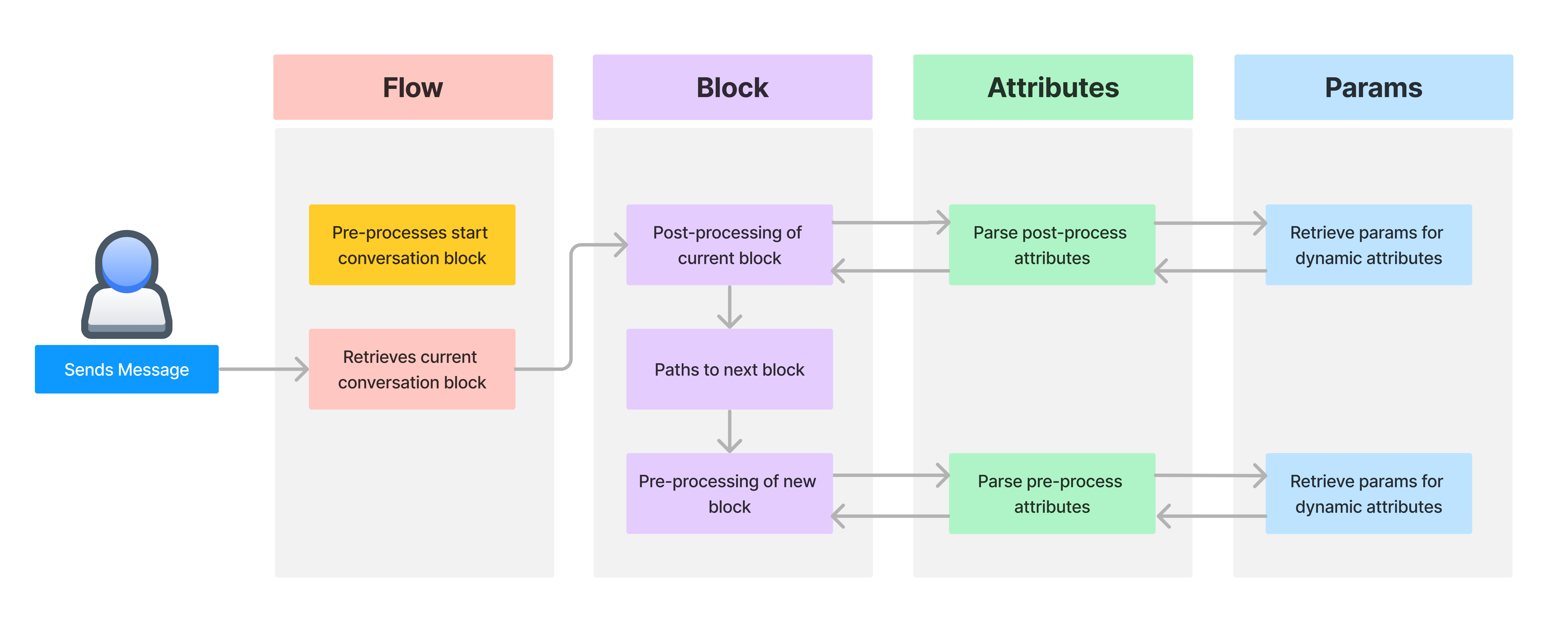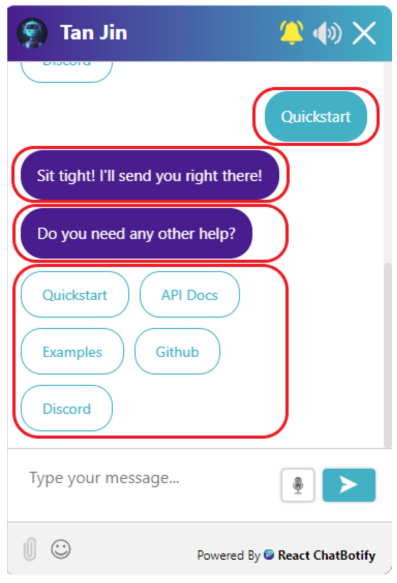Conversations
Conversations refer to the interactions between the bot and the user. Here's how a basic conversation may look like:
const flow = {
start: {
message: "What is your age?",
path: "end"
},
end: {
message: (params) => `I see you are ${params.userInput}!`,
chatDisabled: true
}
}
In a conversation, there are 4 important properties to take note of and they are the Flow (conversation flow), Block (conversation block), Attributes and Params. Below, we observe how these properties interact with each other:

- Upon initializing the chatbot, the chatbot immediately pre-processes the
startblock within a conversation flow (represented by the unique yellow box above). Following which, it patiently waits for a user input. - When a user sends a message (or uploads a file), the current block is retrieved and post-processing is done for it. If a next path is found during post-processing,
then pre-processing of the next block is also done. Notice that both pre-processing and post-processing of a block involves accessing
attributes (e.g.
messagesandpath). For dynamic attributes, params (e.g.userInput) are also involved. - Once the pre-processing of the new block (if applicable) is done, the chatbot again waits for the next user input.
In short, each user input triggers post-processing of a current block and pre-processing of the next block (if applicable)! In between the pre-processing and post-processing of the block is where the chatbot waits for the user input. Now that you have a high level idea of a conversation structure, let us quickly take a look at the details for individual properties.
Flow
Passed in the flow prop of the ChatBot, it can contain any number of blocks to build up an entire conversation. it is compulsory that a flow has minimally the start block which is
the default entry point to a conversation.
Apart from the start block, there are no rules for the naming of other blocks although it is advisable to name your block clearly after its use (e.g. end block for the final block
in your conversation). In the code snippet shown below, the flow contains 2 blocks - the start and end block:
const flow = {
start: {
message: "What is your age?",
path: "end"
},
end: {
message: (params) => `I see you are ${params.userInput}!`,
chatDisabled: true
}
}
Block
Sometimes used interchangeably with a path (as conversations paths from one block to another), it represents the current state of a
conversation and contains attributes (e.g. message) that may be dynamic or static.
Note that the type of attributes available for pre-processing and post-processing are different. In the start block below, message is an attribute that belongs to
pre-processing while path is an attribute that belongs to post-processing. The list of attributes along with their use and categorisation is covered in the section below and may also be found in the API documentation.
start: {
message: "What is your age?",
path: "end"
}
Attributes
Attributes defines the various actions that can be taken within a specific block of conversation between the bot and the user. They are categorised into pre-processing attributes which runs before a user input and post-processing attributes which runs after a user input. The following are considered as user input:
- User sends a message in chat (either by typing/voice)
- User selects an option provided by the bot
- User submits checkbox selection(s) provided by the bot
- User uploads a file
The pre-processing attributes and post-processing attributes provided are as below:
Pre-processing Attributes
The following attributes are processed before user input:
- message
- options
- checkboxes
- render
- chatDisabled
- transition
Post-processing Attributes
The following attributes are processed after user input:
- function
- file
- path
To understand the specifics and how to utilize each attribute, you can consult the API documentation for attributes. You have the freedom to include any combination of these attributes in a block,
whether it's all of them, some of them, or none at all. It's important to note that the attributes are handled in the order they are stated, except for the path attribute, which is
always processed last during post-processing, if it exists.
In the provided snippet of the end block, both the message and chatDisabled attributes are categorized under pre-processing. Since message is declared first, it will be processed
before chatDisabled. It's also worth noting that in this case, message is defined as a dynamic attribute.
end: {
message: (params) => `I see you are ${params.userInput}!`,
chatDisabled: true
}
As the library does not enforce any of these attributes to be compulsory, it is possible to have an empty block but you should note that it will be a dead end that the chatbot will not be able to exit from.
Dynamic Attributes
Dynamic attributes are attributes that can vary its output based on parameter inputs. There are currently 6 dynamic attributes:
- message
- render
- transition
- function
- file
- path
The next section will list all the parameters that may be used in dynamic attributes.
Params
Parameters contain information/functions that can be passed into dynamic attributes for usage/decision making and they are as listed below:
- userInput
- prevPath
- injectMessage
- streamMessage
- openChat
- files (only available for
fileattribute)
As shown in the end code snippet, the parameter used in its message attribute is userInput, accessed via the params object:
end: {
message: (params) => `I see you are ${params.userInput}!`,
chatDisabled: true
}
For details and usage on each of these parameters, do again consult the API documentation for params.
Message

Not to be confused with message from the section on Attributes, the Message component here represents the interactions between the user and the bot. Every element in the chat bot body (including custom render components) are considered a Message (as outlined in red on the image above). Within a message you will find 3 properties:
- content (required) - a string or JSX.Element representing the content of the message
- sender (required) - string representing message sender (can be
user,botorsystem) - type (optional) - either string (for plain text) or object (for JSX elements)
If you are using params.injectMessage, params.streamMessage or the advance custom messages feature, you minimally only need to pass in the content parameter when inserting your own messages. The sender field defaults to bot while type is not required at all. When in doubt, check out examples for details on usage.
Summary
Does that sound like a lot to take in? Fret not! Let us take one final look at the code snippet we saw at the beginning and put things all together. Notice that the ChatBot
takes in the flow that we have just gone through above. Tinker with the live editor below and try out the result for yourself!
const MyComponent = () => { const flow = { start: { message: "What is your age?", path: "end" }, end: { message: (params) => `I see you are ${params.userInput}!`, chatDisabled: true } } return ( <ChatBot options={{theme: {embedded: true}, chatHistory: {storageKey: "conversations_summary"}}} flow={flow}/> ); }; render( <div style={{display: "flex", justifyContent: "center", alignItems: "center"}}> <MyComponent/> </div> )
In the following section, we will explore how you can customize the options for your chatbot to suit your specific needs and preferences!